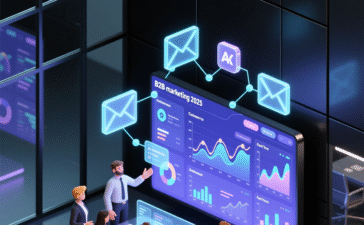Marketing at Scale with AI: The Future is Here
With the launch of generative AI tools such as ChatGPT, it’s clear that artificial intelligence is changing the future of marketing. In 2024, marketers will continue to adopt new technologies that help teams drive revenue and bring strategies to market faster. Here’s a look at how AI is transforming marketing and the trends to watch in the coming year.
Table of Contents
- Trendspotting and Data Analysis
- Streamlining Day-to-Day Marketing Tasks
- AI-Driven Customer Interactions and Conversational Marketing
- New Targeting Solutions
- A New Era of Social Media Marketing
- Improving Customer Experience
- Bringing Your Brand Identity into Your Marketing
1. Trendspotting and Data Analysis
AI-driven data models, algorithms, and machine learning can help marketers better understand their target audience. According to research from The Work Innovation Lab, 30% of employees are already using AI for data analysis, and 62% want to use AI for that purpose. AI tools can help businesses:
- Optimize Spending: Smarter, more targeted advertisements can help maximize the return on investment.
- Plan Better: Accurate trend spotting and predictions allow for more strategic planning.
- Understand Buyer Behavior: Deep insights into buyer behavior can inform more effective marketing strategies.
- Increase Customer Retention: Targeted content can improve customer loyalty and retention.
What is The Work Innovation Lab?
The Work Innovation Lab is a think tank by Asana that develops human-centered, cutting-edge research to help businesses evolve today to meet the growing changes and challenges of work.
2. Streamlining Day-to-Day Marketing Tasks
AI can help marketers move faster by automating routine work. According to research from The Work Innovation Lab, 25% of employees already use AI for administrative tasks, and 57% want to use AI for that purpose. AI productivity improvements will likely include:
- Automations: Instantly kick off, assign, and hand off work.
- Virtual Assistants: Help craft messages, draft status reports, and synthesize marketing campaign information.
- Generative AI Tools: Draft content, create images and videos, and more.
Building AI tools into your marketing tech stack is essential to take advantage of these opportunities. It’s also important to invest in training to overcome AI fears and help marketers use AI technology safely.
3. AI-Driven Customer Interactions and Conversational Marketing
Conversational marketing uses targeted messaging and AI automation to engage with customers in real-time. AI-powered chatbots and virtual assistants are changing the nature of customer service, allowing businesses to:
- Provide Immediate Responses: Meet modern consumer expectations for quick solutions.
- Increase Customer Satisfaction: Real-time engagement can enhance the customer experience.
- Drive Conversions: Intelligent chatbots can guide customers through the purchasing process.
4. New Targeting Solutions
Google is set to phase out third-party cookies in 2024 due to rising privacy concerns. To remain relevant, brands are testing alternative targeting solutions that rely on AI modeling to predict and understand buyer behavior.
5. A New Era of Social Media Marketing
Long-Term Influencer-Brand Relationships
Influencer marketing is expanding, with the industry growing by 29% in 2023. This trend is likely to continue as brands use influencer marketing to:
- Increase Brand Awareness: Reach new audiences through trusted influencers.
- Build Trust: Leverage the credibility of influencers to build consumer trust.
- Set Trends: Influence audience behavior and preferences.
Live Streaming and Video-Based Content
Video-based content and live streaming are key focus areas in social media marketing. The global live streaming market grew to $1.49 billion in 2023, up 20% from 2022. These formats can:
- Drive Engagement: Capture attention and encourage interaction.
- Increase Brand Awareness: Reach a wide audience through dynamic content.
User-Generated Content
User-generated content (UGC) enhances brand authenticity. Consumers prefer seeing photos of real customers over stock photos, and UGC can:
- Enhance Authenticity: Showcase genuine customer experiences.
- Outsource Marketing: Utilize content created by your customer base.
6. Improving Customer Experience
Hyper-Personalization
Consumers expect personalized experiences across all touchpoints. AI and machine learning enable brands to:
- Create Targeted Content: Deliver personalized product recommendations and advertisements.
- Enhance Customer Loyalty: Build stronger connections through tailored experiences.
Improved User Experience Across Devices
Great UX design is essential for converting top-of-funnel consumers. Current UX design trends include:
- Minimalism: Clean, simple layouts.
- Voice-Activated Interfaces: Hands-free controls.
- Animated Elements: Add intrigue and engagement.
- Bold Colors and Video Content: Capture attention and convey messages effectively.
Voice Search Tactics for SEO
Voice search is becoming a significant SEO tool. Businesses are changing how they frame information to:
- Answer Reader’s Questions: Provide high-quality, accurate responses quickly.
VR-Based Tools and Apps
VR and AR marketing tactics are on the rise. These technologies can:
- Create Immersive Experiences: Engage customers with realistic simulations.
- Promote Products: Use VR technology to showcase products in innovative ways.
7. Bringing Your Brand Identity into Your Marketing
Authenticity with AI
As AI technology evolves, customers want to trust that companies are still speaking to them as human beings. Marketers can:
- Incorporate a Human Touch: Blend AI with authentic human interaction.
- Communicate Responsibly: Ensure transparency in how AI is used.
Emphasis on Trust and Consumer Privacy
Consumers want more control over their data. Marketers can build trust by:
- Ensuring Data Security: Protect customer information.
- Communicating Clearly: Be transparent about data usage and protection measures.
Conclusion
Today’s consumers value authenticity, transparency, and privacy more than ever before. With advanced AI technology becoming mainstream, marketers have an opportunity to tie these values into their messaging in new, innovative ways. By staying ahead of these trends and leveraging AI responsibly, businesses can enhance their marketing efforts and build stronger connections with their customers.




